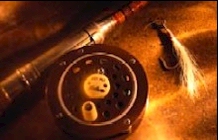|
Chuck Collins learned to tie flies
when he was eight years old, developing a love for fishing and
tying that has continued for 47 years.
His passion for the sport earned
him the title of “Fly Tyer of the Year for the Western Rocky
Mountain Council of the Federation of Fly Fishers” for 2001.
He attributes part of his love for
tying flies to his mother, who tied commercially when she was
pregnant with Chuck.
“I was indoctrinated to fly tying
in the womb,” he says with a laugh.
Over the past years he has honed
his skills and loves the art of tying today for much the same
reason he started: it helps him catch fish.
“I like being able to catch fish
on flies I have tied,” says Collins. “I also think fly tying
makes you a better fisherman. It helps you to understand the food
chain and that you can’t just fish random flies and catch fish.
“There’s always a reason a fish
takes a fly, and tying and studying bugs helps you understand
why.”
Along with the excitement
Award-winning
fly tyer Chuck Collins works on tying a Royal Humpy in his
shop.
 |
of catching fish comes the enjoyment
from the art of tying the flies.
“I also enjoy painting and I make
jewelry,” says Collins. “Sometimes it takes two or more weeks
to finish one of those projects, but if you have 15 minutes you
can sit down and create a little work of art by tying a fly.”
Over the years the biggest change
Collins has seen in fly tying is the materials used and the amount
of information available for tyers to learn new techniques. It’s
also easier for new tyers to get started.
“I remember when you would sit
down and take a fly apart backwards to see how it was tied because
no one was willing to share their secrets,” says Collins. “Fly
tyers were a real tight knit group and if you weren’t in good
with them they wouldn’t show you how to do anything.”
“Today, we have videotapes and
classes taught by some to the best tyers in the country and you
can learn to tie anything,” he says. “The materials used for
tying flies are also a lot better and you can find them.
“There is no reason why people
can’t learn to tie good flies today in just a few months of
practice.”
For new tyers or veteran tyers
wanting to hone their techniques, Collins gives some advice.
“One of the best things a tyer
can do is watch other tyers,” he says. “Veteran tyers can
learn a lot from watching new tyers — they aren’t as hung up
on the traditions of doing things one certain way. They are just
tying the quickest way they know how and you might just learn some
shortcuts.”
Royal Humpy or Goofus Bug
Hook size — 8 to 22
Waxed black thread
White calf body hair
Moose body hair
Deer body hair or light elk calf hair
Red floss
Brown hackle
Wrap the hook in black thread. Tie white calf hair on — don't crowd the eye when doing this. Tie moose hair in place for the tail — the tail should be as long as the body of the hook. After tying in the tail, take deer hair and tie it in at the same point as the tail. Tie hair in with the butt ends pointing toward the eye of the hook. Remove unneeded hair. Wrap in red floss from the point of the tail to the back of the wing. Fold over deer hair and tighten behind the wing. Trim excess hair. Tie in hackle and wrap equally on each side of the wing. Tie off with a whip tie at the eye of the hook. Trim wild hairs and cement head. |


